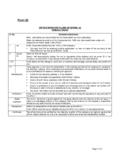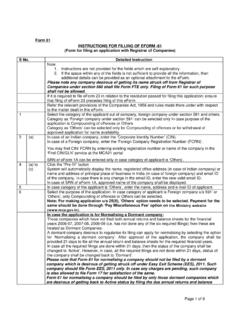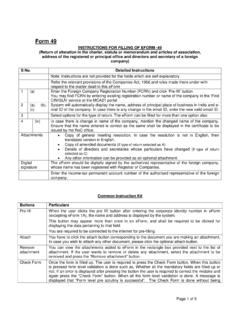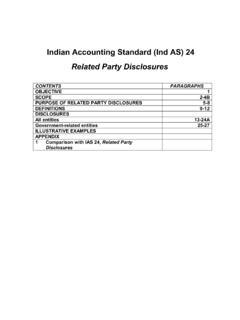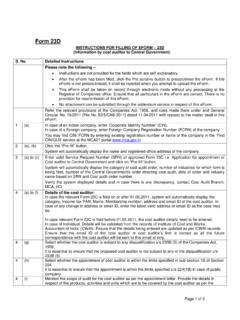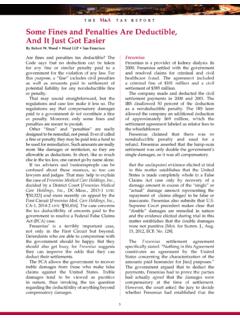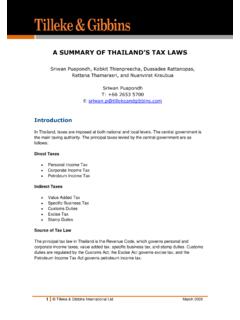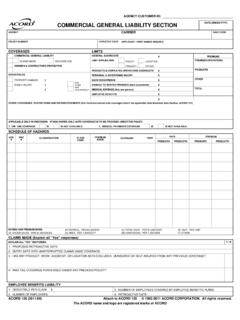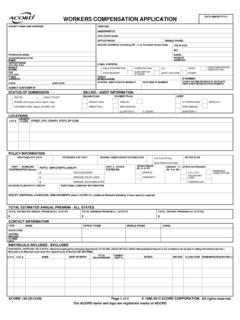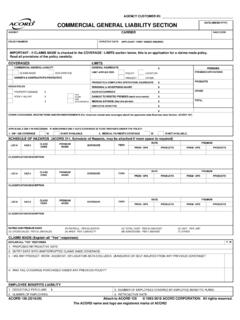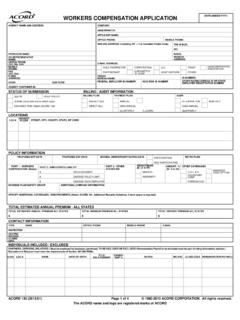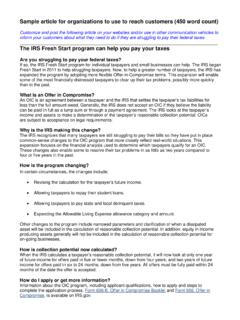Transcription of Indian Accounting Standard (Ind AS) 12
1 Indian Accounting Standard (Ind AS) 12. Income Taxes (This Indian Accounting Standard includes paragraphs set in bold type and plain type, which have equal authority. Paragraphs in bold type indicate the main principles.). Objective The objective of this Standard is to prescribe the Accounting treatment for income taxes. The principal issue in Accounting for income taxes is how to account for the current and future tax consequences of: (a) the future recovery (settlement) of the carrying amount of assets (liabilities). that are recognised in an entity's balance sheet; and (b) transactions and other events of the current period that are recognised in an entity's financial statements. It is inherent in the recognition of an asset or liability that the reporting entity expects to recover or settle the carrying amount of that asset or liability.
2 If it is probable that recovery or settlement of that carrying amount will make future tax payments larger (smaller) than they would be if such recovery or settlement were to have no tax consequences, this Standard requires an entity to recognise a deferred tax liability (deferred tax asset), with certain limited exceptions. This Standard requires an entity to account for the tax consequences of transactions and other events in the same way that it accounts for the transactions and other events themselves. Thus, for transactions and other events recognised in profit or loss, any related tax effects are also recognised in profit or loss. For transactions and other events recognised outside profit or loss (either in other comprehensive income or directly in equity), any related tax effects are also recognised outside profit or loss (either in other comprehensive income or directly in equity, respectively).
3 Similarly, the recognition of deferred tax assets and liabilities in a business combination affects the amount of goodwill arising in that business combination or the amount of the bargain purchase gain recognised. This Standard also deals with the recognition of deferred tax assets arising from unused tax losses or unused tax credits, the presentation of income taxes in the financial statements and the disclosure of information relating to income taxes. 738. Scope 1 This Standard shall be applied in Accounting for income taxes. 2 For the purposes of this Standard , income taxes include all domestic and foreign taxes which are based on taxable profits. Income taxes also include taxes, such as withholding taxes, which are payable by a subsidiary, associate or joint arrangement on distributions to the reporting entity.
4 3 [Refer Appendix 1]. 4 This Standard does not deal with the methods of Accounting for government grants (see Ind AS 20, Accounting for Government Grants and Disclosure of Government Assistance) or investment tax credits. However, this Standard does deal with the Accounting for temporary differences that may arise from such grants or investment tax credits. Definitions 5 The following terms are used in this Standard with the meanings specified: Accounting profit is profit or loss for a period before deducting tax expense. Taxable profit (tax loss) is the profit (loss) for a period, determined in accordance with the rules established by the taxation authorities, upon which income taxes are payable (recoverable).
5 Tax expense (tax income) is the aggregate amount included in the determination of profit or loss for the period in respect of current tax and deferred tax. Current tax is the amount of income taxes payable (recoverable) in respect of the taxable profit (tax loss) for a period. Deferred tax liabilities are the amounts of income taxes payable in future periods in respect of taxable temporary differences. Deferred tax assets are the amounts of income taxes recoverable in future periods in respect of: (a) deductible temporary differences;. (b) the carryforward of unused tax losses; and (c) the carryforward of unused tax credits. 739. Temporary differences are differences between the carrying amount of an asset or liability in the balance sheet and its tax base.
6 Temporary differences may be either: (a) taxable temporary differences, which are temporary differences that will result in taxable amounts in determining taxable profit (tax loss) of future periods when the carrying amount of the asset or liability is recovered or settled; or (b) deductible temporary differences, which are temporary differences that will result in amounts that are deductible in determining taxable profit (tax loss) of future periods when the carrying amount of the asset or liability is recovered or settled. The tax base of an asset or liability is the amount attributed to that asset or liability for tax purposes. 6 Tax expense (tax income) comprises current tax expense (current tax income).
7 And deferred tax expense (deferred tax income). Tax base 7 The tax base of an asset is the amount that will be deductible for tax purposes against any taxable economic benefits that will flow to an entity when it recovers the carrying amount of the asset. If those economic benefits will not be taxable, the tax base of the asset is equal to its carrying amount. Examples 1 A machine cost Rs. 100. For tax purposes, depreciation of Rs. 30 has already been deducted in the current and prior periods and the remaining cost will be deductible in future periods, either as depreciation or through a deduction on disposal. Revenue generated by using the machine is taxable, any gain on disposal of the machine will be taxable and any loss on disposal will be deductible for tax purposes.
8 The tax base of the machine is Rs. 70. 2 Interest receivable has a carrying amount of Rs. 100. The related interest revenue will be taxed on a cash basis. The tax base of the interest receivable is nil. 3 Trade receivables have a carrying amount of Rs. 100. The related revenue has already been included in taxable profit (tax loss). The tax base of the trade receivables is Rs. 100. 4 Dividends receivable from a subsidiary have a carrying amount of Rs. 100. The dividends are not taxable. In substance, the entire carrying amount of the asset is deductible against the economic benefits. Consequently, the tax base of the dividends receivable is Rs. 100.(a). 5 A loan receivable has a carrying amount of Rs. 100.
9 The repayment of the loan 740. will have no tax consequences. The tax base of the loan is Rs. 100. (a) Under this analysis, there is no taxable temporary difference. An alternative analysis is that the accrued dividends receivable have a tax base of nil and that a tax rate of nil is applied to the resulting taxable temporary difference of Rs. 100. Under both analyses, there is no deferred tax liability. 8 The tax base of a liability is its carrying amount, less any amount that will be deductible for tax purposes in respect of that liability in future periods. In the case of revenue which is received in advance, the tax base of the resulting liability is its carrying amount, less any amount of the revenue that will not be taxable in future periods.
10 Examples 1 Current liabilities include accrued expenses with a carrying amount of Rs. 100. The related expense will be deducted for tax purposes on a cash basis. The tax base of the accrued expenses is nil. 2 Current liabilities include interest revenue received in advance, with a carrying amount of Rs. 100. The related interest revenue was taxed on a cash basis. The tax base of the interest received in advance is nil. 3 Current liabilities include accrued expenses with a carrying amount of Rs. 100. The related expense has already been deducted for tax purposes. The tax base of the accrued expenses is Rs. 100. 4 Current liabilities include accrued fines and penalties with a carrying amount of Rs. 100. fines and penalties are not deductible for tax purposes.
